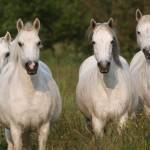Keep Horses with Severe Asthma on Pasture

Properly managed, horses with an asthma syndrome, such as recurrent airway obstruction or heaves, spend little time stalled. Inadequate pasture, severe weather, and inconvenience precludes some owners from keeping asthmatic horses outdoors, putting them at risk of respiratory distress. Stalled horses with severe asthma, including those in remission after treatment with corticosteroids and bronchodilators, have significantly increased airway inflammation compared to horses kept on pasture, according to a recent study*.
“Allergens present in forages, feeds, and bedding induce severe airway inflammation, exaggerate contraction of airways, and result in the production of mucus. These changes in the lungs ultimately result in obstruction of the airways,” explained Laura Petroski, B.V.M.S., a veterinarian for Kentucky Equine Research. “In turn, airway obstruction causes coughing, elevated respiratory rate, and exercise intolerance, all classic signs of asthma syndrome.”
“Corticosteroids and omega-3 fatty acids, such as the DHA and EPA found in EO•3, reduce inflammation in the airways and lung tissues, and bronchodilators increase the diameter of the lower airways. These therapies reduce obstruction and help achieve asthma remission,” noted Petroski. Increased mucous production, decreased airway inflammation, and reduced fibrosis, or scarring, of tissues deep within the lungs occur when an asthmatic horse is in remission.
This study confirms previous data that suggests structural changes to the airways during times of asthma exacerbation can be reversed. Despite this, experts recommend avoiding asthma exacerbation in at-risk horses rather than treating a flare-up.
In addition to supplementation with EO•3, owners should consider hay soaking, alternative bedding, low-dust forages and feeds, barn ventilation, and as much turnout as possible to minimize disease signs.
“This study was conducted in horses with severe equine asthma and not horses with summer pasture-associated obstructive pulmonary disease. Horses in the latter category actually do need to be stabled at certain times of the year or relocated to a more suitable climate or geographic location,” Petroski said.
*Bullone, M., P. Joubert, A. Gagné, et al. Bronchoalveolar lavage fluid neutrophilia is associated with the severity of pulmonary lesions during equine asthma exacerbations. Equine Veterinary Journal. In press.








